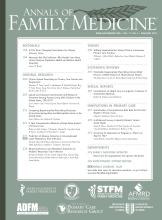Article Figures & Data
Tables
- Table 1
Characteristics of Patients Referred to the Integrated Behavioral Health Program in Primary Care, July 1, 2015 to December 31, 2016 (N = 2,690)
Characteristic Percent of Total Attended Initial Appointment No. (%) Age, y 18-40 50.04 514 (38.19) 41-64 44.68 511 (42.51) ≥65 5.28 62 (43.66) Female sex 58.74 611 (38.67) Race/ethnicity Non-Hispanic black/African-American 47.14 472 (37.19) Non-Hispanic white 24.05 292 (45.13) Other or missing race 9.44 113 (44.49) Hispanic/Latino (any race) 19.33 210 (40.38) Primary language English 81.00 877 (40.25) Non-English 19.00 210 (41.10) Insurance Medicaid 58.10 601 (38.45) Medicare 13.64 147 (40.05) Commercial 21.08 254 (44.80) Other 4.91 57 (43.18) Behavioral health diagnosesa Depression 28.74 324 (41.91) Anxiety 17.06 186 (40.52) Bipolar disorder 2.90 36 (46.15) Panic disorder 2.23 21 (35.00) PTSD 6.58 82 (46.33) Schizophrenia 9.44 116 (45.67) Substance use disorder 18.25 192 (39.10) Medical comorbidities Type 2 diabetes 15.43 171 (41.20) Chronic obstructive pulmonary disease 19.29 209 (40.27) Received warm handoff 20.15 221 (40.77) Time from referral to scheduled initial appointment Same day as referral 6.80 150 (81.97) >1 d, but ≤30 d after referral 71.00 766 (40.10) >30 d after referral 21.97 169 (28.60) PTSD = posttraumatic stress disorder.
↵a Taken from problem lists in the electronic health record.
- Table 2
Analysis of Patient Characteristics Associated With Attendance at Initial Integrated Behavioral Health Appointments in Primary Care
Variable Unadjusted OR (95% CI) P Value Adjusted OR (95% CI)a P Value Age, y 18-40 1.00 1.00 41-64 1.20 (1.02-1.40) .03 1.31 (1.1-1.56) .002 ≥65 1.25 (0.88-1.78) .20 1.42 (0.96-2.11) .081 Sex Female 1.00 1.00 Male 1.19 (1.02-1.39) .03 1.13 (0.96-1.33) .15 Race/ethnicity Non-Hispanic black/African-American 1.00 1.00 Hispanic (any race) 1.14 (0.93-1.41) .21 1.15 (0.93-1.43) .20 Non-Hispanic white 1.39 (1.15-1.68) .0008 1.35 (1.10-1.67) .004 Other/missing race 1.35 (1.03-1.78) .03 1.42 (1.07-1.88) .016 Insurance Medicaid 1.00 1.00 Medicare 1.06 (0.84-1.33) .64 0.95 (0.73-1.24) .70 Commercial 1.28 (1.06-1.56) .01 1.32 (1.07-1.61) .008 Other 1.20 (0.84-1.72) .31 1.26 (0.86-1.83) .23 Behavioral health diagnosisb Substance use disorder 0.94 (0.77-1.14) .52 0.75 (0.60-0.95) .016 Bipolar disorder 0.79 (0.50-1.23) .30 0.89 (0.55-1.46) .66 PTSD 0.77 (0.57-1.05) .10 0.74 (0.53-1.03) .076 Schizophrenia 0.79 (0.61-1.02) .07 0.80 (0.61-1.06) .13 Received warm handoff 1.02 (0.84-1.23) .85 0.96 (0.79-1.18) .71 Appointment scheduled on same day as referral 7.62 (5.18-11.20) <.0001 11.66 (7.65-17.76) <.001 Appointment within 1 mo 0.96 (0.81-1.13) .61 1.67 (1.37-2.05) <.001
Additional Files
The Article in Brief
Warm Handoffs and Attendance at Initial Integrated Behavioral Health Appointments
Christine A. Pace , and colleagues
Background In programs that integrate behavioral health services into primary care, "warm handoffs," in which primary care clinicians introduce patients to behavioral health professionals, are commonly used. This study set out to determine if warm handoffs are associated with improved attendance at subsequent behavioral health appointments.
What This Study Found Warm handoffs are not associated with improved attendance at behavioral health intake appointments. It has been theorized that warm handoffs could build patients' trust in behavioral health clinicians and reduce patients' stigma about behavioral health care, potentially translating to improved attendance at behavioral health appointments. Instead, researchers found that the most significant predictor of attendance at an initial intake was time from referral until appointment, consistent with other studies in specialty mental health and other clinical settings.
Implications
- The authors call for a prospective study comparing different types of warm handoffs to standard referrals to determine if warm handoffs improve attendance at initial intake appointments and which features are most beneficial. Such a study could also evaluate whether certain patient groups benefit more than others from warm handoffs, and if this type of referral can help address disparities in attendance across demographic groups and diagnoses.
- In the interim, they suggest that making wait times for appointments as brief as possible is likely to improve attendance at integrated behavioral health intake appointments.







